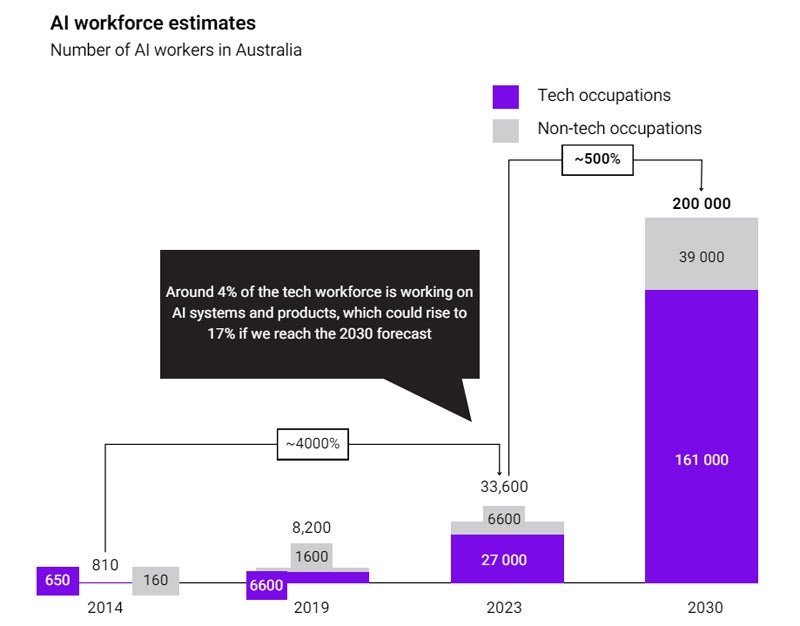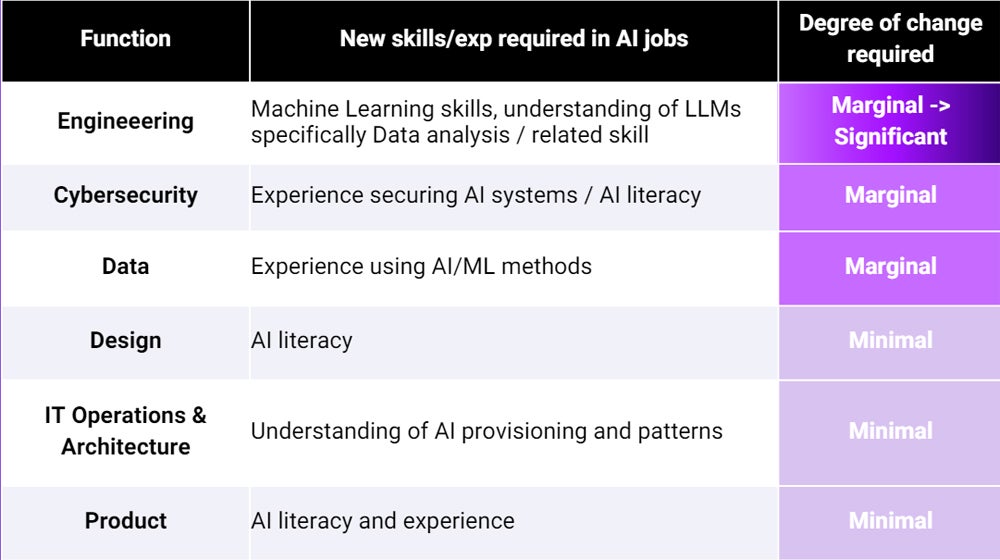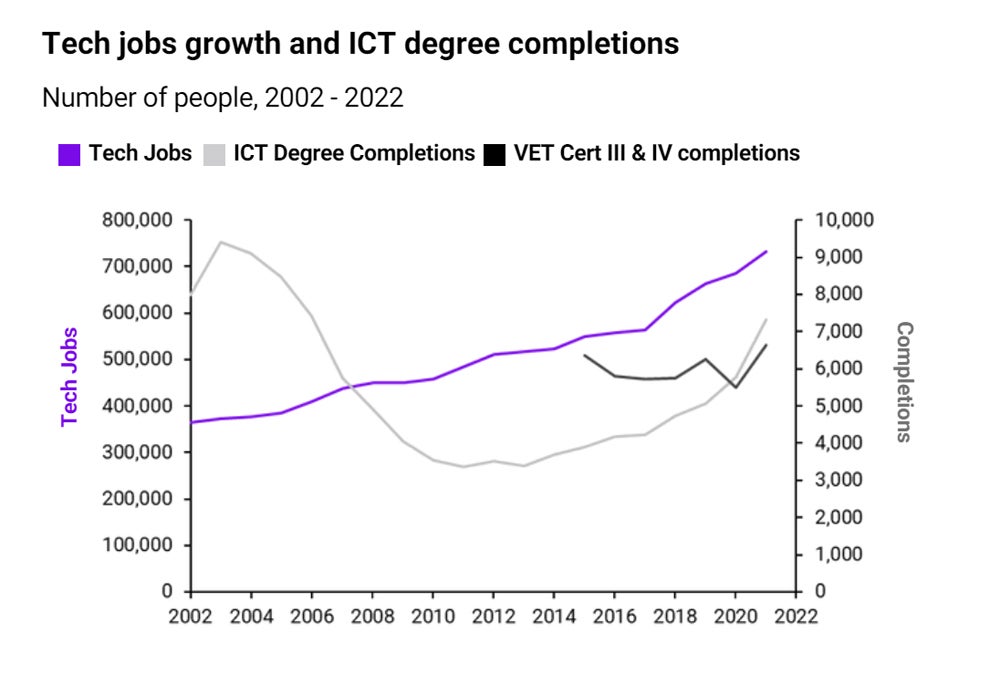A boom in artificial intelligence has the potential to create 200,000 AI-related jobs in Australia by 2030, according to a report from the Technology Council of Australia. This presents significant opportunities for current tech workers and other professionals to secure well-paid jobs and build careers in a rapidly growing sector.
The TCA report, supported by Microsoft, LinkedIn and Workday, states that realising this opportunity will require a 500% growth in AI jobs over the next seven years. These roles will span both tech and non-tech fields, from developers to those marketing and selling AI products, as well as those managing personnel involved with AI.
A combination of entry-level training in digital and AI skills, upskilling of existing tech workers and mid-career training for those with transferable skills could open doors to AI jobs. The TCA also recommends leveraging skilled migration to fill roles with international talent.
Predicted AI job growth in Australia by 2030
Australia’s AI workforce included just 800 workers in 2014, according to the TCA. Amid an AI technology expansion both in Australia and globally, the number of AI workers rose to 33,000 in 2023, accounting for about 4% of the total local technology workforce.
The CSIRO, Australia’s national science body, predicted in its 2019 AI Roadmap that Australia could have up to 161,000 specialist AI workers by 2030. The TCA’s estimate of 200,000 includes non-tech occupations supporting the scaling, governing and managing of AI systems.

If achieved, AI jobs will grow much faster than other occupations. For example, all tech occupations grew by 46% between 2016 and 2023. Other high-growth occupations, such as aged and disabled carers as well as registered nurses, are expected to grow by just 20% and 17% respectively, by 2030.
What AI roles will become available in Australia?
Roles related to the development or deployment of AI models, systems and products will account for the bulk of new AI job opportunities in Australia, according to the TCA report. These roles will draw from different technology roles and similar STEM “feeder” occupations.
The TCA has estimated the extent of retraining or reskilling needed for tech professionals in various roles to transition into AI-specific roles. For example, engineering professionals will need significant retraining in areas like machine learning and data analysis.

Factors influencing AI development job growth by 2030
AI development roles are expected to see high or medium rates of workforce growth based on existing growth patterns, according to the TCA. This takes into account factors including the expected supply of new talent through training and the impact of AI and automation on existing roles, expected to be high for tech roles in design, data and engineering.

Which AI-related jobs are predicted to grow in Australia?
Various non-technology roles will be essential to support the growth of AI in Australia, contributing to a total of 200,000 job opportunities in the country. The TCA outlines roles involved in the scaling, governance and management of AI in Australia.
Jobs that will support the scaling of AI
Scaling occupations are involved in the commercialisation and scaling of AI systems. They include:
- Sales.
- Customer experience.
- Human resources.
- Marketing.
- Finance.
- Operations.
The TCA said that while the core skills in these roles are likely to remain stable, employers filling AI-related scaling roles will prefer candidates with a strong understanding of the context in which they are working, including AI markets and trends.
Which jobs will support the governing of AI?
Governing roles take in the legal, policy and risk, and compliance areas and include titles such as lawyer, AI safety officer and policy manager. These roles will be focused on developing and maintaining ethical, legal and other controls required to ensure compliance of AI systems.
SEE: Why data governance is a focus for Australian IT professionals in 2024
The TCA expects that, while there will be enough candidates for these roles, the skill shift required for an AI-supporting role could be more significant in these professions.
Which jobs will support the management of AI?
Jobs in managing AI, including CEOs and chief AI officers, will involve setting organisation-level strategies and ensuring alignment across other jobs in AI. The TCA said there is no shortage of local candidates, but an uplift in AI literacy across Australian management will be required.
There may be recruitment overseas for talent unavailable in Australia. The TCA said that this would be for management roles that require a deep level of technical experience or that are niche markets for Australia, such as scaling deep tech companies.
What salaries will be offered for AI jobs in Australia?
How AI salaries will trend through 2030 is unclear. However, AI skills are likely to be in high demand, potentially outstripping supply in AI development roles. This would push salaries for AI jobs higher, as has been the case in the Australian tech sector over the last decade.
According to Clicks IT Recruitment, the average salary for an AI engineer in Australia in 2024 is AUD $151,665 per year or AUD $1,065 per day. Entry-level roles begin at $133,335 per year, while senior level positions for top technology candidates can pay up to $176,665 per year.
What could stop Australia from creating new AI jobs?
Ensuring a supply of skilled AI workers will be the main challenge. The TCA’s report said that past experience shows that growth in AI jobs may not result in a greater uptake of AI skills training among Australian learners and workers, leading to skill shortages in the industry.
For example, despite high, sustained jobs growth for tech workers over 20 years, Australians did not consistently undertake more tech training through the university or vocational education and training system, leading to “a generation of missing tech workers.”

This could suit those who want to seize the opportunity in Australia or abroad. Any difficulty redirecting Australians into new AI jobs could result in more career opportunities and salary growth, as the gap between AI jobs demand and available skills for jobs widens.
How Australia can deliver 200,000 AI jobs by 2030
The delivery of such a high number of jobs and skills in AI will be challenging. Australia’s compliance-heavy VET sector has been slow to adapt to digital skills training, and there are other areas of the tech sector competing for job candidates, including cyber security.
The TCA is urging for the creation of an “AI Investment and Capability Plan” to address this and other AI-related problems. It says the development of skills-based initiatives should be part of a broader plan to grow Australia’s AI capability to capitalize on the market’s future opportunity.
There are other areas the TCA has recommended be included as part of the solution.
Retraining pathways may be expanded and diversified
VET and short-course offerings could be adapted for AI, through an expansion of existing programs, co-designing new courses with industry, introducing new micro credentials or creating modern, digital apprenticeships. Mid-career professionals could use shorter course training to reskill, while entry-level talent would have AI skills fed into course options.
AI jobs skills promoted to raise jobs awareness
AI skills and careers could be promoted to enhance awareness of the numerous job opportunities being created. This would help individuals choosing careers and those looking to transition understand that AI careers are a viable option. Additionally, it would highlight the existing training and career pathways that lead to jobs and career growth in AI.
Skilled migration used to meet AI skills needs
Australia is undertaking reforms to its skilled migration, which will help Australia attract global AI-related talent with faster visa processing and by removing occupation lists. The removal of occupation lists will be particularly impactful for AI jobs, the TCA suggests, because “occupations may emerge much faster than official statistical systems can keep up”.
Promoting AI literacy across the workforce
The TCA has called for widespread training initiatives to boost AI literacy in the workforce to prepare for widespread AI adoption. This is likely to see a broader introduction of AI-related training as part of employee onboarding and upskilling programs. The TCA adds this should include upskilling senior management in AI governance and adoption.
AI work to be intertwined with Australia’s future workforce
In a press release, TCA CEO Damian Kassabgi said AI is one of the leading tech trends transforming how Australians will work in the future.
“We’ve seen enormous growth in Australia’s AI workforce in recent years, which will only increase with greater adoption of the technologies,” he said.
An important realisation is that AI roles will extend to non-technology roles, he added. “We will need people with skills in areas such as human resources, sales and governance to successfully scale these systems and businesses to harness the potential in front of us.”


